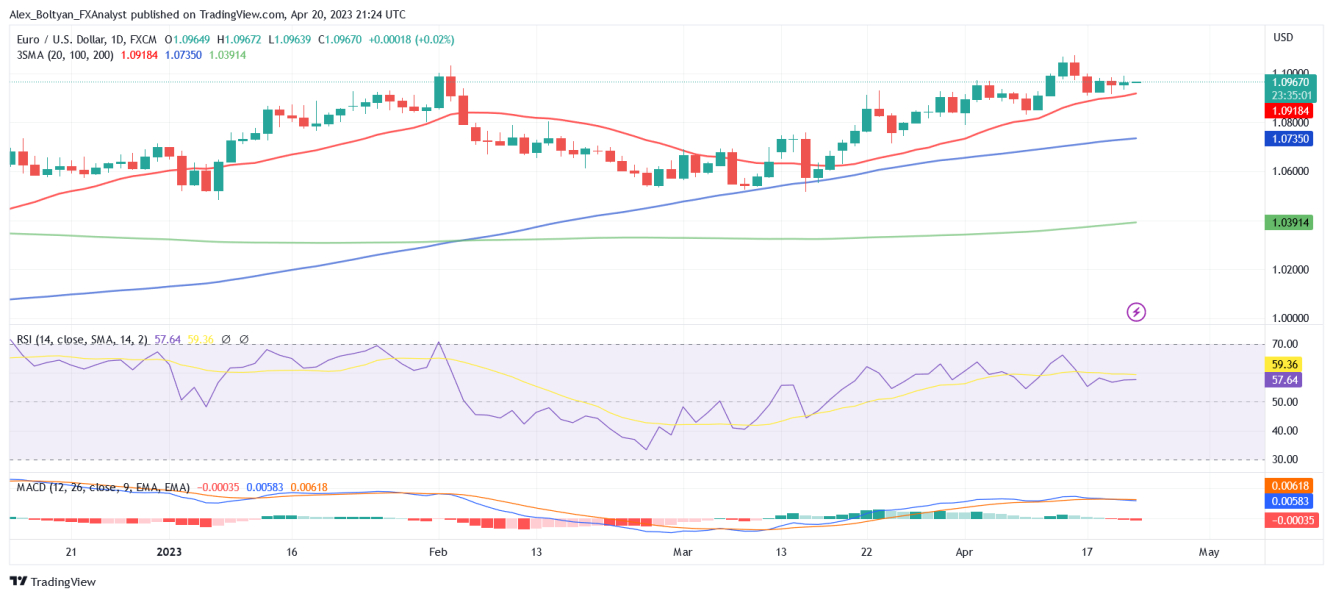The EUR/USD pair advanced modestly on Thursday but overall continues to move sideways in a familiar range as global markets fluctuate in the absence of catalysts and first-tier data. At the time of writing, the EUR/USD pair is trading at the 1.0965 area, 0.10% above its opening price.
On Thursday, the European Central Bank released the March policy meeting accounts, which revealed that most policymakers agreed to raise rates by 50 bps despite acknowledging uncertainty in the current situation. However, the minutes showed that some members would have preferred to delay the increase until financial market tensions had subsided. Other takes showed the growth projections for 2024, and 2025 were weaker than what was previously projected in December.
Meanwhile, across the pond, soft U.S. data sparked recession fears. The Philadelphia Fed Manufacturing Index came in at -31.3 in April, much worse than expected. In addition, initial jobless claims for the week ended on April 14 printed 245,000, above the 240,000 expected, and the continued claims reached the highest level since November 2021 at 1.865 million in the previous week.
U.S. bond yields retreated, with the 10-year yield settling at 3.53%, the lowest in three days. Wall Street main indexes closed in the red. The S&P 500 dropped 0.60%, the Dow Jones lost 0.33%, while the Nasdaq Composite shed 0.80%. 
From a technical standpoint, the EUR/USD maintains a short-term bullish bias, although indicators are exhibiting lack of momentum on the daily chart. The RSI and MACD indicators remain in positive territory but with flat slopes, while the pair trades above its main moving averages but capped below the 1.1000 mark.
The pair needs to regain the 1.1000 level to target the April monthly high of 1.1075. On the other hand, immediate support levels could be found at the 20-day SMA at around 1.0920 and 1.0900.
- English (UK)
- English (India)
- English (Canada)
- English (Australia)
- English (South Africa)
- English (Philippines)
- English (Nigeria)
- Deutsch
- Español (España)
- Español (México)
- Français
- Italiano
- Nederlands
- Português (Portugal)
- Polski
- Português (Brasil)
- Русский
- Türkçe
- العربية
- Ελληνικά
- Svenska
- Suomi
- עברית
- 日本語
- 한국어
- 简体中文
- 繁體中文
- Bahasa Indonesia
- Bahasa Melayu
- ไทย
- Tiếng Việt
- हिंदी
EUR/USD Remains Limited Below 1.1000
Published 04/20/2023, 05:26 PM
Updated 07/09/2023, 06:32 AM
EUR/USD Remains Limited Below 1.1000
Latest comments
Loading next article…
Install Our App
Risk Disclosure: Trading in financial instruments and/or cryptocurrencies involves high risks including the risk of losing some, or all, of your investment amount, and may not be suitable for all investors. Prices of cryptocurrencies are extremely volatile and may be affected by external factors such as financial, regulatory or political events. Trading on margin increases the financial risks.
Before deciding to trade in financial instrument or cryptocurrencies you should be fully informed of the risks and costs associated with trading the financial markets, carefully consider your investment objectives, level of experience, and risk appetite, and seek professional advice where needed.
Fusion Media would like to remind you that the data contained in this website is not necessarily real-time nor accurate. The data and prices on the website are not necessarily provided by any market or exchange, but may be provided by market makers, and so prices may not be accurate and may differ from the actual price at any given market, meaning prices are indicative and not appropriate for trading purposes. Fusion Media and any provider of the data contained in this website will not accept liability for any loss or damage as a result of your trading, or your reliance on the information contained within this website.
It is prohibited to use, store, reproduce, display, modify, transmit or distribute the data contained in this website without the explicit prior written permission of Fusion Media and/or the data provider. All intellectual property rights are reserved by the providers and/or the exchange providing the data contained in this website.
Fusion Media may be compensated by the advertisers that appear on the website, based on your interaction with the advertisements or advertisers.
Before deciding to trade in financial instrument or cryptocurrencies you should be fully informed of the risks and costs associated with trading the financial markets, carefully consider your investment objectives, level of experience, and risk appetite, and seek professional advice where needed.
Fusion Media would like to remind you that the data contained in this website is not necessarily real-time nor accurate. The data and prices on the website are not necessarily provided by any market or exchange, but may be provided by market makers, and so prices may not be accurate and may differ from the actual price at any given market, meaning prices are indicative and not appropriate for trading purposes. Fusion Media and any provider of the data contained in this website will not accept liability for any loss or damage as a result of your trading, or your reliance on the information contained within this website.
It is prohibited to use, store, reproduce, display, modify, transmit or distribute the data contained in this website without the explicit prior written permission of Fusion Media and/or the data provider. All intellectual property rights are reserved by the providers and/or the exchange providing the data contained in this website.
Fusion Media may be compensated by the advertisers that appear on the website, based on your interaction with the advertisements or advertisers.
© 2007-2025 - Fusion Media Limited. All Rights Reserved.
